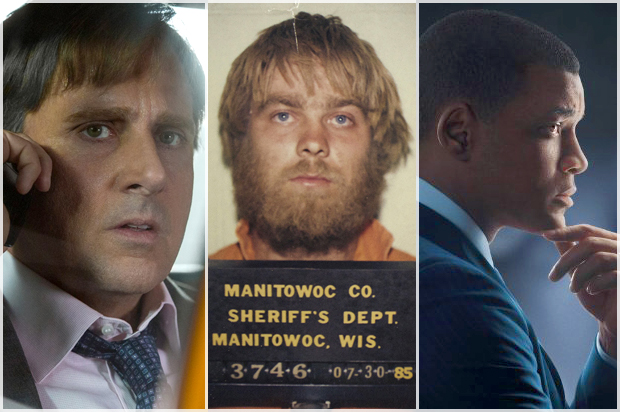Pop culture is drenched in bureaucratic corruption right now. Between “Making a Murderer,” “Concussion” and “The Big Short,” we have three portraits of flawed institutions, seemingly lacking in a clear villain. None point to a single figure responsible for the unethical nonsense on display. Instead, in each distinct yet eerily similar story, it’s clear that unquestioning cooperation is required for corruption to prosper. It takes a village to induce depravity.
First off, we have “Making a Murderer,” which presents a police force so irrationally hellbent on putting a man away for a crime, they practically brainwash themselves into believing their suspect is guilty. It’s worth noting that there’s certainly an alternative way of presenting the content of Stephen Avery’s trial. Like most documentaries, “Making a Murderer” has a clear opinion that it doesn’t work to obscure. Still, in the effort of proving Avery and his nephew Brendan Dassey were framed for the murder of Teresa Halbach, the potential for unethical behavior quickly spans the Manitowac County hierarchy. From Lt. James Lenk to prosecutor and “Fraggle Rock” monster Ken Kratz or Dassey’s own lawyer Len Kachinsky, few hands are left clean. In order to simplify things for the jury, the defense would like to argue that one or two people could have planted the pieces necessary to convict Avery. Perhaps they’re right. But, as the case unfolds, we see a system built on unethical practices like coercing testimony and concealing evidence. It’s little wrongdoings from a laundry list of people that add up to a sentencing that will more than likely rob a man of his life.
In, “Concussion,” a similar phenomenon is at play. In light of Dr. Bennet Omalu’s discovery of chronic traumatic encephalopathy, the National Football League convinces itself that its precious hobby is not dangerous to its players (or, depending on your level of cynicism, deliberately covers up the fact that it is). Since “Concussion” is a dramatization of real-life events unlike “Making a Murderer,” there was certainly more of an opportunity to send up a clear antagonist. Yet, while NFL chairman Roger Goodell leads the public charge against Omalu’s condemning findings, it is clear that the effort to conceal the possible side effects of the sport straddles the business of football in its entirety. Press reps, suits and the doctors they hire are all partially responsible for allowing the condition to remain hidden. This is not Goodell huddling up employees and telling them to keep quiet about evidence of CTE; it’s a system of people each doing their small part to prevent Omalu from disrupting the status quo, if only by staying quiet.
Structural corruption is at its most brazen in “The Big Short.” The film reveals crookedness so far-reaching it extends through entire companies, ultimately poisoning the whole of the American banking system. It’s tough to explain the way the housing market falls apart (and Adam McKay goes out of his way to simplify things, recruiting Anthony Bourdain and Margot Robbie in a bathtub to break it all down). Put most simply, by the end of the film it’s clear the banks likely knew mortgages would fail and didn’t bother to fix things, assuming the taxpayers would bail them out. As Steve Carell’s character puts it, creasing his brow into the depths of his dramatic role, “They knew, they just didn’t care.” The “they” in that simple statement hits on how entrenched and far-reaching the issues lie. Again, it’s not some awful, mustachioed CEO directing his company to destroy the lives of millions of Americans, because “Muahaha, profit anyway.” It’s an industry holistically complicit in accepting crookedness as the way business that is done.
Finishing “Making a Murderer” or leaving the theater after “Concussion” or “The Big Short,” the questions of “who’s responsible?” and “how could they let this happen?” linger. The knee-jerk reaction looks to the dark psychology of authority, the banality of cogs in the machine following orders, but there’s no Hitler stand-in in any of the three stories. Rather, we see a structural lack of ethics built on the sum total of individual ethical infractions. Each scenario seems like an implausibly malicious case, leading to false imprisonment, fatal injuries or our country’s near-financial ruin, but lining them up reveals more mundane forces fueling the devastation. And so, the question turns to our own culpability. In order to watch each film without descending into despair, we have to look at how the portraits of corruption they reveal reflect back on ourselves. We are all susceptible to the phenomenon we see on-screen. These are often perfectly “normal,” often boring people, going about their day without asking questions. The takeaway should be that there is not always going to be a horned creature demanding you “do your job.” We all play a role in the systems that allow for these horrors, sometimes just by letting things be. In Manitowoc County, the NFL, Wall Street and far outside the boundaries of each, evil can be as simple as going with the flow.

